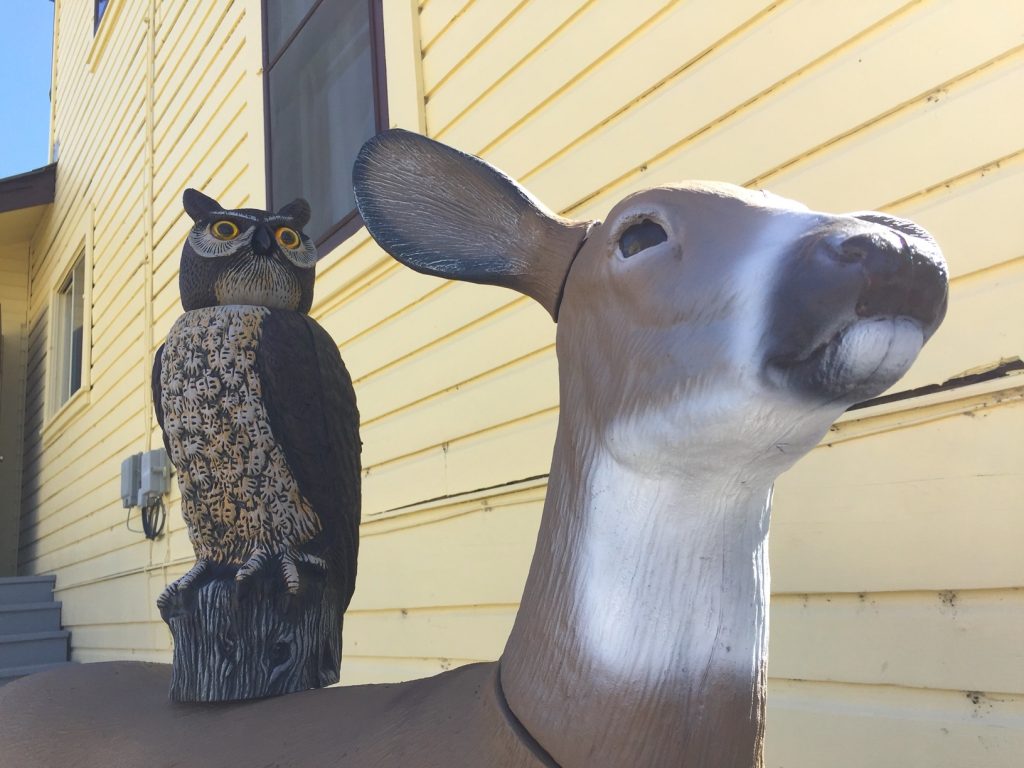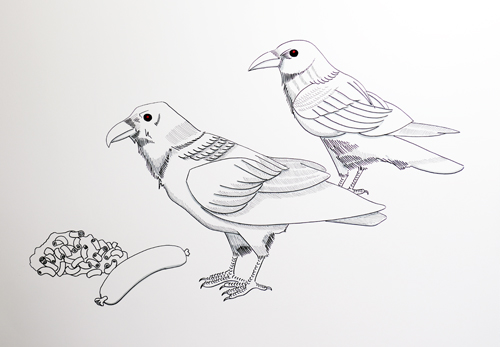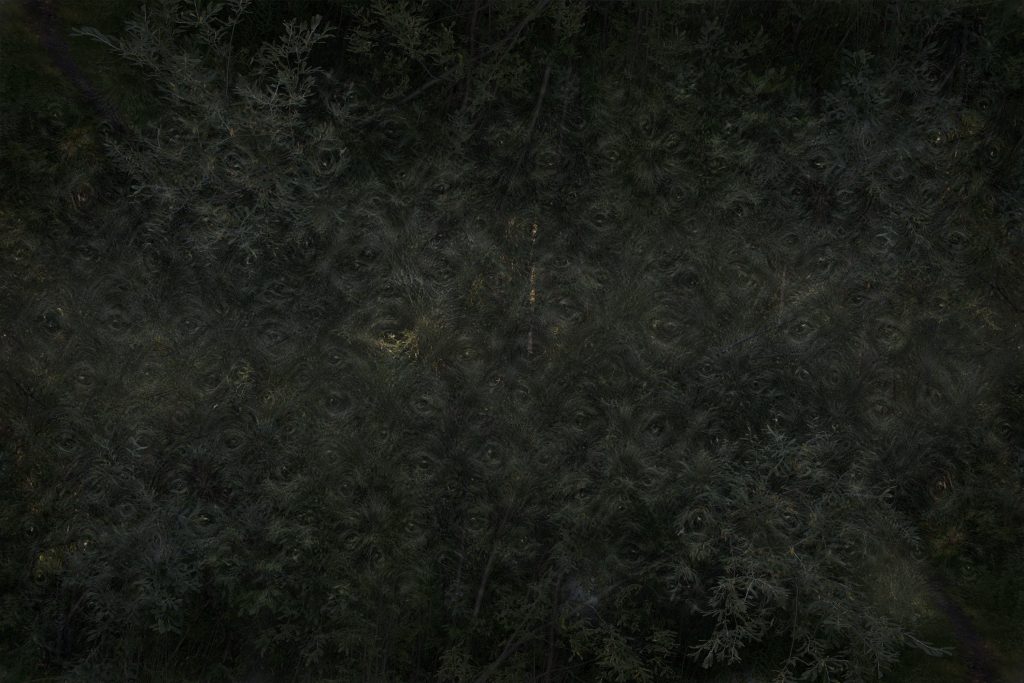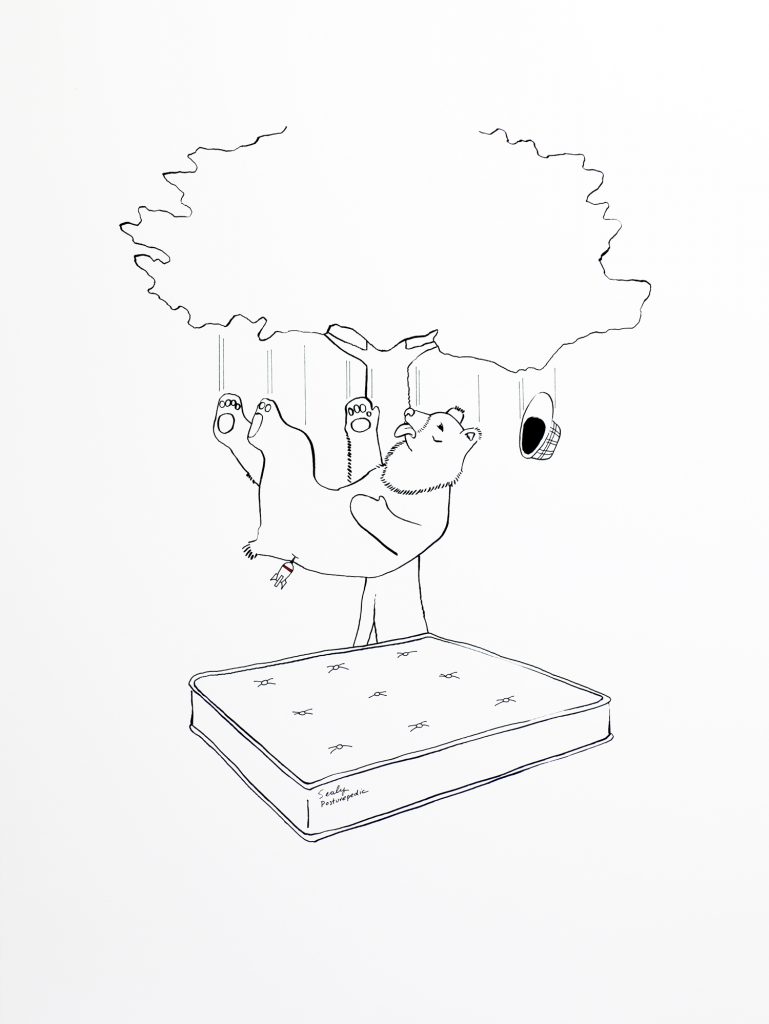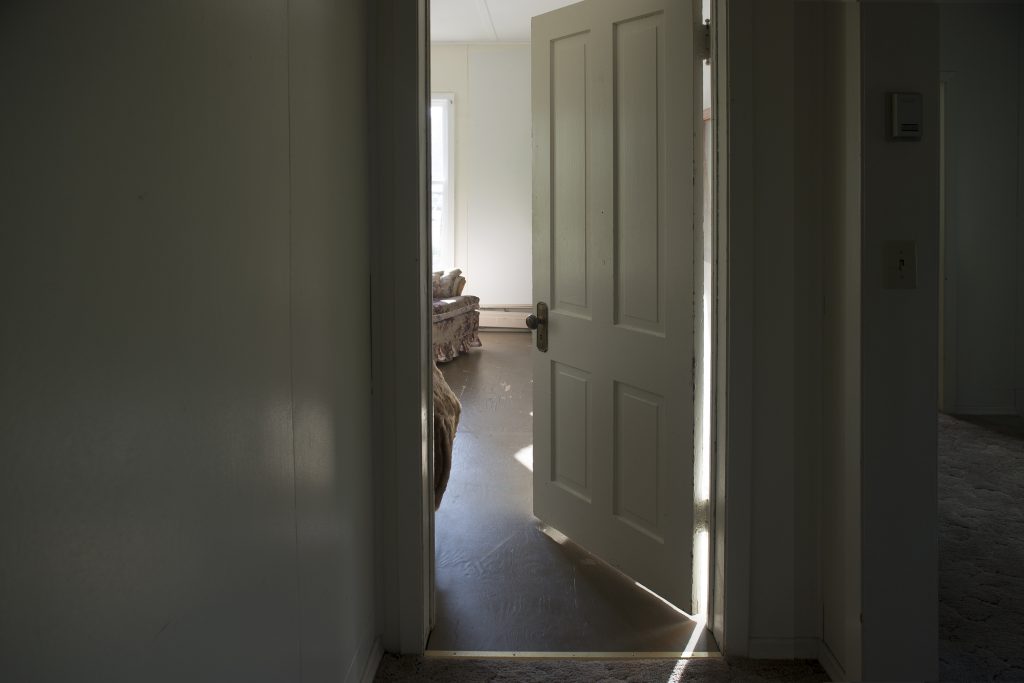Post exhibition text 2017
Tall Tales for Short Nights and Warm Planets
By Exhibition Curator Marlaina Buch
Narrative accounts of human/animal interactions are complex records. Encounter tales starring animals trend tall. Recollections of brief meetings between species are frequently spectacular, and carry in them ideas about humanity and our place in the world. In these tellings, animals are often symbols, omens, scapegoats, or guides to our wilder selves. Our inability to fully understand creatures that don’t use the same systems as us (language chiefly, but also gesture and expression) creates a gap easily filled with conjecture. To meet another creature’s eyes feels significant, meaningful – “It looked right at me.” Storytelling transforms sightings with the desires, fears, and imaginings of the narrator, frequently revealing more about the reporter than the subject.
Wild animals are mysterious and charismatic, they arrest our attention in the moments we share with them. Animals are indicators of seasonality, abundance (or scarcity), migration patterns, and changes in the biological condition of an ecosystem. Animal sightings connect us to the wider environmental web, acting as a gateway to noticing other subtler natural communities of plants, insects, fungi, rocks, and elements. Falling in love with a magnificent owl could make you curious about its home, what it eats, where it sleeps. You might spend more time trying to see one, looking for signs of its presence, listening for its call, wandering around at dusk. You might see other secretive, magical things happen when you walk in the woods. This attention can broaden the knowledge base of how creatures behave and what new pressures act upon them. If people don’t spend time on the land, ears pricked, eyes scanning, the environmental memories of previous generations are foreshortened. If comparative changes in the natural world aren’t recorded and transmitted to a population that sticks around, there is less cause for alarm when things shift. The baseline of what’s normal in the natural world shrinks to a few seasons, a few stories. Animal encounter reports are a way of communicating what is being observed in the natural world. Comparative reports can preserve the biological history of a place and mark when changes occur.
Artists Leila Armstrong and Lisa Hirmer spent 6 weeks in Dawson City collecting stories of animal encounters from locals, tourists, and transients. These tales informed the creation of new artworks based on community research and collaboration. As with any sample, certain themes recurred. The recent appearance of species uncommon to northerly climes was noted, as was the necessity of bartering with the town’s resident sassy ravens. Stories tended to break down into three rough categories: tourist stories told by visitors, local stories centered around feelings of wonder or awe, local stories that involved considerable negotiation between humans and animals. Collectively, these stories acted as an informal case history of human/animal interactions in the Dawson area.
Tourist stories followed an arc without a rising action, crisis or climax, and tended to be flat accounts of seeing an animal at the roadside, usually at a distance in a vehicle. Photographing the animal would conclude the story and leave the photographer with an image that captured the thrill of the encounter, represented an authentic moment with place, and could be shared with others as an emblematic travel experience. These accounts left the artists without much to interpret, but helped to identify the kinds of animals one might see in the Yukon. Stories were characterized by spatial and emotional distance, and reinforced the idea that animals occupy a space that is different from humans – somewhere “out there in the wild.”
Stories from local residents that focused on feelings of fascination with seeing wild animals described animals as being in “their” appropriate environment/habitat/space, a space slightly different than those normally occupied by humans. These stories were observational and lasted longer, where humans and animals shared a brief moment as their paths crossed, with a very perceptible sense of their bodies being adjacent. Proximity played an important role. The landscape was pulled much closer into the encounter, feeling more like a room than a vast forest or vista. Storytellers remarked that they felt awe in the presence of animals and the gaze between them was reported to have felt significant or personal.
Hirmer’s photograph A Glassiness to the Eyes came from a curiosity in the human-animal gaze, the common moment in a story when eyes meet and something is exchanged between two species. It was created using Google’s Artificial Neural Networks, programming designed to simulate the human brain’s ability to recognize images. Hirmer applied a version of this code to an image of the forest around Crocus Bluff, a popular place to look out at Dawson and the surrounding landscape. Surprisingly, the neural network “saw” an astonishing number of eyes in a scene a human brain would instantly know was just forest, reminding us of the incredibly complex capacity, fine-tuned by evolution, of the human/animal mind to instantly recognize eyes looking at us. Hirmer then overlaid the original forest image with this “eye image”, creating a composite wallpaper with mysterious, fairytale qualities that draws us into an uncanny gaze.
Far and away the most common and most interesting stories told by locals involved a great deal of negotiation between humans and animals, where the interaction required sustained attention, confusion about communication, and resulted in an unpredictable resolution. These stories described the uncertainty of animals coming into human space – mostly yards, sheds, dog pens, greenhouses, outhouses, etc. When animals entered into places where humans live, work, and survive, very practical issues came into play, and often involved considerable complexity. A typical story arc would describe surprise at encountering an animal in an atypical space, a struggle to understand the animal’s non-verbal communication cues, occasional misinterpretation of an animal’s intentions or feelings, and a desire to come to a mutually copacetic outcome, which was not always achieved. These stories made for more satisfying source material because they followed the structure of dialogue – information being passed back and forth in a continuously recalibrated exchange, rather than one way interpretation. Animals felt much more like co-creators of the story and active participants instead of subjects or mysterious, speechless, unknowable entities. Interestingly, in negotiation stories, an animal’s status fluctuated considerably depending on its perceived willfulness. Bears in particular were singled out as being potentially problematic visitors, not only dangerous, but likely to return. Bears that could not be convinced to leave after a few attempts to shoo them away (with gunshots, pepper spray, or banging pots and pans, among other techniques) were often shot. Fear and unpredictability escalated interactions quickly and recategorized bears into pests, with rapid action necessary to avoid a situation worsening or safety being significantly impacted. Often the decision to deal with bears more harshly was made after determining they were “not afraid of humans.” Not all bear stories finished this way. Several described moments of sometimes uncomfortable or unsure bargaining combined with curiosity, wonder, and feelings of successfully communicating with a bear.
Lisa Hirmer’s photographic series Certainties to which we’ve become accustomed, was inspired by differences in stories told by tourists (seeing an animal at a remove, on the side of the road, as separate from the viewer) and locals (animals in shared space, animals crossing into human space, where there is more of a negotiation). Hirmer wanted to “capture the sense of a startling encounter with a large animal in the spaces we think of as ours.” These images of animals in domestic spaces mimic the way we often see animals in nature – as a quick glimpse in forest – but instead are in the spaces in which we feel most at ease, where everything is scaled to our bodies and an animal encounter is truly unsettling.
Leila Armstrong’s drawings capture the climax point of the most compelling negotiation stories collected. Their cartoon style implies a narrative where outcomes and morals can only be guessed at and human and animal characters often swap places. Armstrong targets the ways stories can shift with a simple change of protagonist, context, or location. These drawings are a partial reveal of a more complex account, but highlight the uncertainties of storytelling and our deep desire to fill in information where it’s missing.
The exhibition’s decoy animals act as narrative prompts, encouraging viewers to think about their own encounter stories. Animal representations, whether as miniatures, reproductions, or decorations create an immediate jumping off point for narrative. The animals chosen are present in the local area, but occupy a more minor presence or are newcomers filling new niches created by climate change. Their presence in the gallery points to greater shifts happening out on the land.
Humans make up all kinds of narratives about animals, some more instructive than others. This too is a matter of positioning, of perspective. The degree of assumed difference between humans and animals is cultural. A person whose culture believes animals are ancestors and whose relationship with nature is one of kinship and belonging will tell a story different from one whose culture believes animals are separate, unknowable beings or pests to be “dealt with.” Embodied, emotional, sensory encounters with animals can challenge abstract ideas about nature and who we think we are relative to “nature.” Encountered animals aren’t passive characters onto which all meaning is projected, but rather are active, unstable, uncontrollable non-human actors–they make the story along with the person, though their experience remains beyond our absolute understanding. This has particular implications for how we interact with each other as humans whose codes, expectations and customs don’t always align, in a changing world where uncertainty, negotiation, and competition for resources are encountered every day. When we anthropomorphize or tell tall tales, those narratives say more about us than the animal we’ve encountered. By simply being present and watchful, we can begin to think about animals in terms of their own experiences, in their own environment.
Marlaina Buch makes art, writes, organizes exhibitions, facilitates community projects and falls somewhere on the arts spectrum between maker and doer. She has a background in art education and public engagement and her practice uses creative education, experiential and collaborative workshops, typography, printmaking, critical writing and performance to investigate social and environmental challenges, absurdity, and the potential of public space. She lives in Nanaimo BC.
www.marlainabuch.com

